Home? A Remote Scottish Island
Lord of the Isles, until Trump developer arrives
In a “stop the world, I want to get off” fantasy, I thought about moving to Scotland, my forefathers’ ancestral homeland. I've discovered that Donald Trump is likely to follow me there. He’s more Scottish than I am, and certainly part of the Scottish diaspora. His mother, Mary Anne MacLeod, grew up on the nearby Isle of Lewis and he likes to say “it’s g…
Keep reading with a 7-day free trial
Subscribe to Slender Threads / Global Citizens / Public History to keep reading this post and get 7 days of free access to the full post archives.




